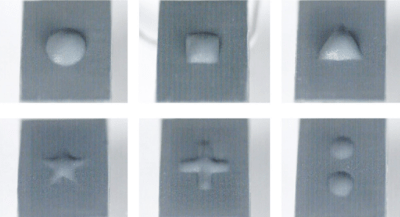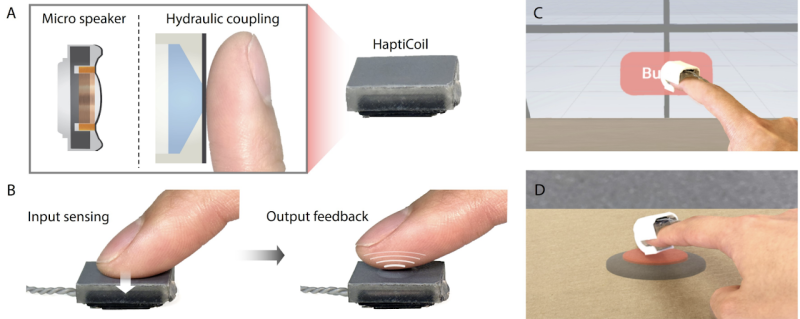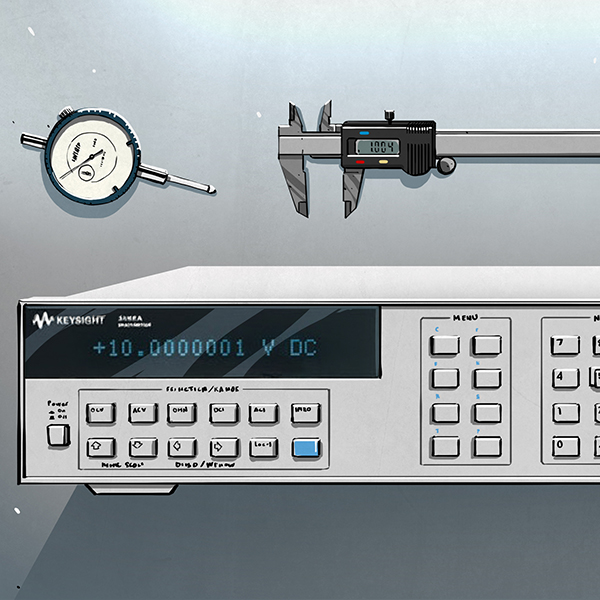There’s just something about a satisfying “click” that our world of touchscreens misses out on; the only thing that might be better than a good solid “click” when you hit a button is if device could “click” back in confirmation. [Craig Shultz] and his crew of fine researchers at the Interactive Display Lab at the University of Illinois seem to agree, because they have come up with an ingenious hack to provide haptic feedback using readily-available parts.

The “hapticoil”, as they call it, has a simple microspeaker at its heart. We didn’t expect a tiny tweeter to have the oomph to produce haptic feedback, and on its own it doesn’t, as finger pressure stops the vibrations easily. The secret behind the hapticoil is to couple the speaker hydraulically to a silicone membrane. In other words, stick the thing in some water, and let that handle the pressure from a smaller soft button on the silicone membrane. That button can be virtually any shape, as seen here.
Aside from the somewhat sophisticated electronics that allow the speaker coil to be both button and actuator (by measuring inductance changes when pressure is applied, while simultaneously driven as a speaker), there’s nothing here a hacker couldn’t very easily replicate: a microspeaker, a 3D printed enclosure, and a silicone membrane that serves as the face of the haptic “soft button”. That’s not to say we aren’t given enough info replicate the electronics; the researchers are kind enough to provide a circuit diagram in figure eight of their paper.
In the video below, you can see a finger-mounted version used to let a user feel pressing a button in virtual reality, which raises some intriguing possibilities. The technology is also demonstrated on a pen stylus and a remote control.
This isn’t the first time we’ve featured hydraulic haptics — [Craig] was also involved with an electroosmotic screen we covered previously, as well as a glove that used the same trick. This new microspeaker technique does seem much more accessible to the hacker set, however.
















Can a button like this be abused as a microphone?
Just about all speakers can be microphones. Since they’re already measuring the inductance, it’s just a little bit further. It’d be a pretty terrible microphone, though.
seems like a nice one for a braille interface?
That sounds like great idea! It could be display and input all in one.
Braille needs 6 or 8 points activated independently, which requires 6 or 8 coils. So in theory you can build a kind of 1 finger (index) glove, the tip of the finger has the dots, while the rest of the glove hosts the corresponding coils and pipes and tubes leading the liquid to the tip of the finger. Add more buttons for play, stop, forward, backward and so on in the palm. You’ll need a battery too.
This seems to be a solved problem?
My iPhone has solid haptic feedback, as does my Magic Trackpad, which I’m convinced is physically broken when the battery runs out as the “click” is so convincing that even though intellectually I know it’s haptics, when it doesn’t do it, it feels like a stuck button.
I don’t think this is unique to Apple? Though perhaps the fine tuning to make it convincing is – a Microsoft mouse I tried had the haptic badly miscalibrated, I thought it gave me an electric shock when I clicked it…
Decades ago Nokia patented a haptic feedback touch screen. It’d simulate the feel of buttons on the screen. Neat, but never made it to the market.